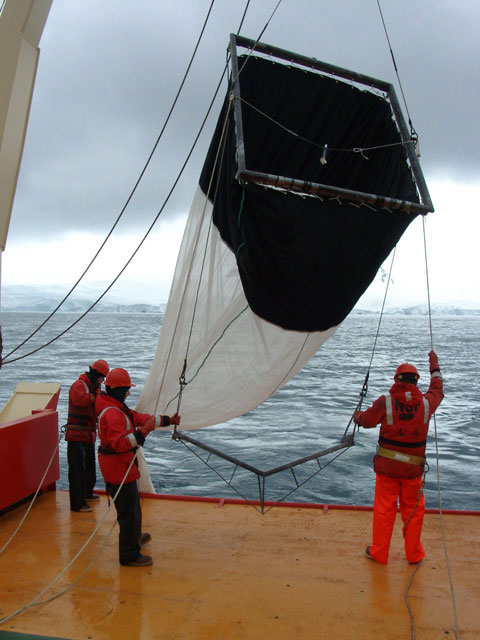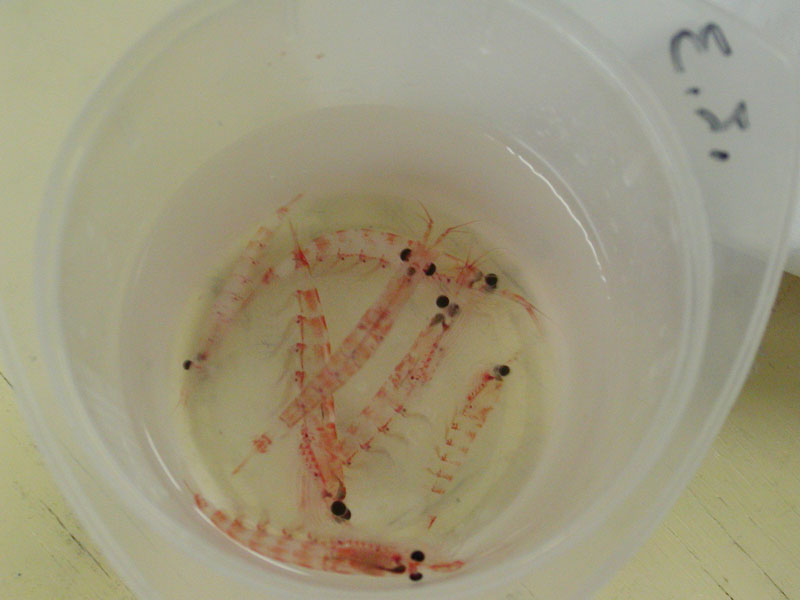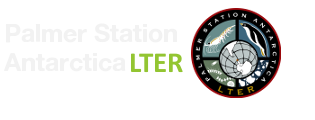Zooplankton
Group PI: Debbie Steinberg
Zooplankton and micro-nekton, particularly those > 0.2 mm in length, provide the main trophic link between primary producers and apex predators in the southern Ocean. Within the Palmer LTER study region, both oceanic and coastal zooplankton assemblages occur. The oceanic assemblage (generally in waters > 2000m) includes salps, whereas the coastal assemblages (shelf break and slope) includes several species of euphausiids, including Antarctic krill (Euphausia superba) and Thysanöessa macrura, and the herbivorous shelled pteropod, Limacina helicina. Over much of the shelf region both the oceanic and coastal assemblages occur in varying mixes year to year with no clear boundaries between zones. In parts of the PAL grid close to the continent, two species (larval Antarctic silverfish, Pleuragramma antarcticum, and the ice krill, E. crystallorophias) have been found in a zone of cold continental shelf water influenced by summer sea ice. Climate change, in particular changes in seasonal sea ice dynamics showing trends in longer periods of open water in summer, is apt to favor species with life histories that are less dependent on sea ice.
Temporal/spatial variability in the distribution and abundances of the zooplankton assemblages, in particular any changes in distribution, has been one focus of the research on zooplankton and micronekton. Another focus is the population dynamics of Antarctic krill, an important prey item for many seabirds and seals, and environmental factors impacting its growth, reproduction and ultimately recruitment success. Seasonal sea ice dynamics have been documented as important factors in both reproduction and recruitment success of this species.


Team Members
Selected Publications
- Ross, Robin M., Quetin, Langdon B., Baker, Karen S., Vernet, Maria, and Smith, Raymond C., Growth limitation in young Euphausia superba under field conditions. Limnology and Oceanography, 45 (1), 31-43, 2000.
- Quetin, Langdon B., and Ross, Robin M., Environmental variability and its impact on the reproductive cycle of Antarctic Krill. American Zoologist, 41 (1), 74-89, 2001.
- Quetin, Langdon B., Ross, Robin M., Frazer, Thomas K., Amsler, Margaret O., Wyatt-Evens, Carol, and Oakes, Stephanie A., Growth of larval krill, Euphausia superba, in fall and winter west of the Antarctic Peninsula. Marine Biology, 143 (5), 833-843, 2003.
- Quetin, Langdon B., and Ross, Robin M., Episodic recruitment in Antarctic krill, Euphausia superba, in the Palmer LTER study region. Marine Ecology Progress Series, 259, 185-200, 2003.
- Ducklow, Hugh W., Doney, Scott C., and Steinberg, Deborah K., Contributions of long-term research and time-series observations to marine ecology and biogeochemistry. Annual Reviews of Marine Science, 1, 279-302, 2009. DOI 10.1146/annurev.marine.010908.163801.








 This site was developed with the support of the National Science Foundation under Grant No. OPP-2224611 and OPP-2026045. Any opinions, findings, and conclusions or recommendations expressed in this material are those of the authors and do not necessarily reflect the views of the National Science Foundation.
This site was developed with the support of the National Science Foundation under Grant No. OPP-2224611 and OPP-2026045. Any opinions, findings, and conclusions or recommendations expressed in this material are those of the authors and do not necessarily reflect the views of the National Science Foundation.